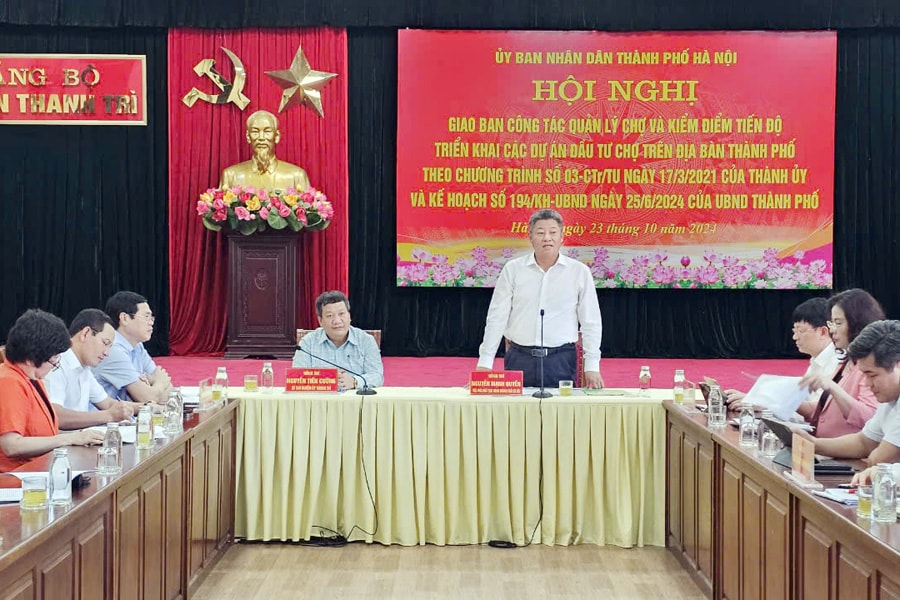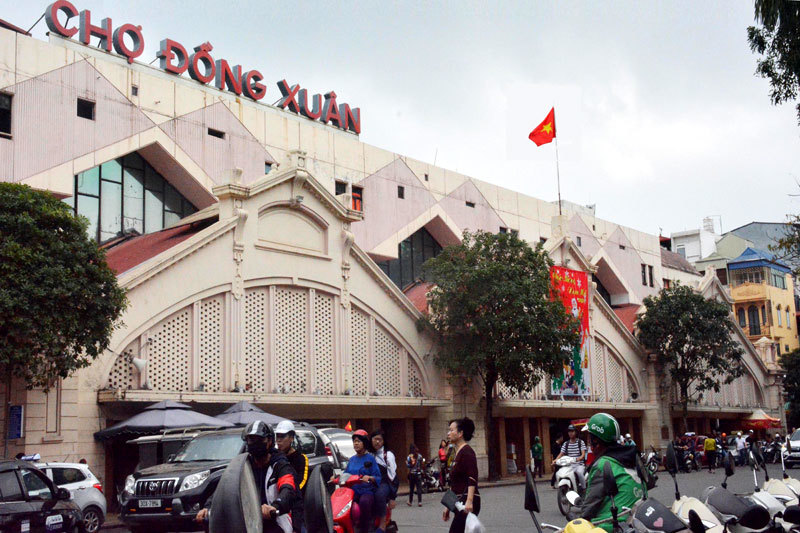
Hoan Kiem District has been tasked with showcasing regional specialties and One Commune One Product (OCOP) items from across the country at Dong Xuan Market, the largest wholesale market in the capital, aiming to offer a diverse selection for tourists exploring the city's historic Old Quarter and its wet markets.
The initiative was given by Nguyen Manh Quyen, Deputy Chairman of the Hanoi People's Committee, at a meeting last week on the management of investment projects for markets.
| Nguyen Manh Quyen, Deputy Chairman of the Hanoi People's Committee, chairs the meeting on Hanoi market management. Photo: Hanoimoi Newspaper |
Meanwhile, Hoang Mai District has been asked to work with the city's Department of Industry and Trade and relevant sectors to develop the Hoang Mai wholesale fish market into a major seafood hub for the city.
"This market will offer a variety of fresh sea and freshwater aquatic products from different provinces and imported sources, as well as cooperate with travel companies to provide food experiences for domestic and international tourists," added the deputy chairman of Hanoi.
According to Quyen, the two wholesale markets in Hoan Kiem and Hoang Mai districts are essential components of the capital city's market management program for 2022-2025, which aims to establish 20 new markets and upgrade 37 existing ones. Districts are encouraged to seek investment from the private sector.
"Districts need to ensure that vendors are committed to food safety and traceability and that they adopt cashless transactions," Quyen stressed.
At the meeting, Hanoi's Department of Industry and Trade reported that the city's wet markets have boosted trade and increased local government revenues, facilitated commerce, and met the needs of residents, especially in suburban areas.
The city plans to build four new markets and renovate seven existing outlets by the end of 2024. By the end of 2025, two more new markets will be completed in Bac Tu Liem and Nam Tu Liem districts, and ten more will be renovated.
The department noted that the upgrading of the markets has created jobs and increased income for many workers. There are currently 455 markets in the city, ranging from category one to three. Wet markets meet nearly 40% of demand in urban areas and 70% in rural areas.
However, many markets are dilapidated and do not comply with food safety, fire prevention, urban security, and environmental hygiene regulations. In addition, certain neighborhoods do not have enough local markets to meet the needs of the populace, leading to the establishment of unauthorized market sites. Since March, the department and local authorities have intensified efforts to renovate and modernize traditional markets. In particular, four new markets have already opened, including Phu Do (Nam Tu Liem District), Dong Tam (Hai Ba Trung District), Tram Troi Central Market (Hoai Duc District), and Chau Long (Ba Dinh District). By the end of October, many districts had renovated and upgraded 19 out of 38 markets.
Challenges in upgrading Hanoi's markets
| Dong Xuan Market in Hoan Kiem District is a major wholesale and retail market and a tourist attraction in Hanoi. Photo: The Hanoi Times |
To address these challenges, Nguyen Kieu Oanh, Deputy Director of Hanoi's Department of Industry and Trade, urged the Ministry of Finance to set up mechanisms to waive or reduce land rent and provide interest rate incentives for market construction investment funds.
She also called on the Hanoi government to prioritize public investment funds for market construction and to ensure that funds are available for renovations according to the criteria set by the city's Party Committee.
"Districts should report on challenges related to planning and investment in shopping centers, markets, and supermarkets. This will help the Department of Industry and Trade work with relevant agencies to address the challenges," Oanh said.
Nguyen Manh Quyen, Deputy Chairman of the city government, instructed the Department of Industry and Trade to analyze management issues related to markets, including classification, service pricing, food safety, and fire prevention. He emphasized the need to develop a plan to address all outstanding issues.
He also called for the timely updating of mechanisms and policies in accordance with the Capital Law to make them supportive of the city's market rehabilitation efforts.
Regarding 37 illegal market sites, Nguyen Manh Quyen urged local authorities to assess and draw up a detailed plan to clear these sites, with the aim of completion by the end of 2025.






- Vietnam set to increase power imports
- Vietnam may prioritize economic growth over inflation control: PM
- Vietnam's exports at risks as US tariffs loom
- Vietnamese Gov’t plans to revise up 2025 GDP growth target to over 8%
- Number of green buildings in Vietnam doubles in 2024
- Vietnam prepares for potential global trade wars: PM


